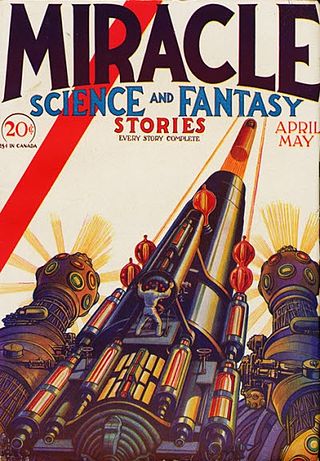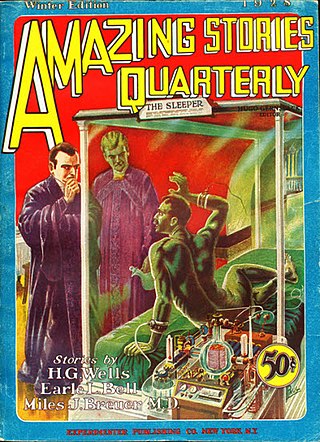
Robert William Chambers was an American artist and fiction writer, best known for his book of short stories titled The King in Yellow, published in 1895.

Scientific romance is an archaic, mainly British term for the genre of fiction now commonly known as science fiction. The term originated in the 1850s to describe both fiction and elements of scientific writing, but it has since come to refer to the science fiction of the late nineteenth and early twentieth centuries, primarily that of Jules Verne, H. G. Wells and Arthur Conan Doyle. In recent years the term has come to be applied to science fiction written in a deliberately anachronistic style as a homage to or pastiche of the original scientific romances.

A romance novel or romantic novel generally refers to a type of genre fiction novel which places its primary focus on the relationship and romantic love between two people, and usually has an "emotionally satisfying and optimistic ending." Precursors include authors of literary fiction, such as Samuel Richardson, Jane Austen, and Charlotte Brontë.

Thaddeus Maxim Eugene (Ted) Dikty was an American editor who also played a role as one of the earliest science fiction anthologists, and as a publisher.

LGBT themes in speculative fiction include lesbian, gay, bisexual, or transgender (LGBT) themes in science fiction, fantasy, horror fiction and related genres. Such elements may include an LGBT character as the protagonist or a major character, or explorations of sexuality or gender that deviate from the heteronormative.

Fantasy literature is literature set in an imaginary universe, often but not always without any locations, events, or people from the real world. Magic, the supernatural and magical creatures are common in many of these imaginary worlds. Fantasy literature may be directed at both children and adults.

Jupiter, the largest planet in the Solar System, has appeared in works of fiction across several centuries. The way the planet has been depicted has evolved as more has become known about its composition; it was initially portrayed as being entirely solid, later as having a high-pressure atmosphere with a solid surface underneath, and finally as being entirely gaseous. It was a popular setting during the pulp era of science fiction. Life on the planet has variously been depicted as identical to humans, larger versions of humans, and non-human. Non-human life on Jupiter has been portrayed as primitive in some works and more advanced than humans in others.

Neptune has appeared in fiction since shortly after its 1846 discovery, albeit infrequently. It initially made appearances indirectly—e.g. through its inhabitants—rather than as a setting. The earliest stories set on Neptune itself portrayed it as a rocky planet rather than as having its actual gaseous composition; later works rectified this error. Extraterrestrial life on Neptune is uncommon in fiction, though the exceptions have ranged from humanoids to gaseous lifeforms. Neptune's largest moon Triton has also appeared in fiction, especially in the late 20th century onwards.
Everett Franklin Bleiler was an American editor, bibliographer, and scholar of science fiction, detective fiction, and fantasy literature. In the late 1940s and early 1950s, he co-edited the first "year's best" series of science fiction anthologies, and his Checklist of Fantastic Literature has been called "the foundation of modern SF bibliography". Among his other scholarly works are two Hugo Award–nominated volumes concerning early science fiction—Science-Fiction: The Early Years and Science-Fiction: The Gernsback Years—and the massive Guide to Supernatural Fiction.

Lesbian literature is a subgenre of literature addressing lesbian themes. It includes poetry, plays, fiction addressing lesbian characters, and non-fiction about lesbian-interest topics.

Class S, or S kankei, abbreviated either as S or Esu (エス), is an early twentieth-century Japanese wasei-eigo term used to refer to romantic friendships between girls. The term is also used to designate a genre of girl's fiction which tells stories about the same, typically focused on senpai and kōhai relationships wherein one girl is senior in age or position to the other. The "S" is an abbreviation that can stand for "sister", "shōjo", "sex", "schön", and "escape".

The Time Stream is a science fiction novel by American writer John Taine. The novel was originally serialized in four parts in the magazine Wonder Stories beginning in December 1931. It was first published in book form in 1946 by The Buffalo Book Company in an edition of 2,000 copies of which only 500 were ever bound. It is the first novel to see time as a flowing stream.
The Diothas; or, A Far Look Ahead is a 1883 utopian novel written by John Macnie and published using the pseudonym "Ismar Thiusen". The Diothas has been called "perhaps the second most important American nineteenth-century ideal society" after Edward Bellamy's Looking Backward (1888).
The Milltillionaire, or Age of Bardization is a work of utopian fiction written by Albert Waldo Howard, and published under the pseudonym "M. Auberré Hovorré." The book was one element in the major wave of utopian and dystopian literature that characterized the final decades of the nineteenth century.

An Entirely New Feature of a Thrilling Novel!: Entitled, The Social War of the Year 1900; Or, Conspirators and Lovers! is an American utopian novel by Simon Mohler Landis. Self-published in 1872 to commercial failure, it is regarded by some critics as one of the worst novels ever written.

Miracle Science and Fantasy Stories was an American pulp science fiction magazine which published two issues in 1931. The fiction was unremarkable, but the cover art and illustrations, by Elliott Dold, were high quality, and have made the magazine a collector's item. The magazine ceased publication when Dold became ill and was unable to continue his duties both as editor and artist.

Benita: An African Romance is a novel by H. Rider Haggard.

Amazing Stories Quarterly was a U.S. science fiction pulp magazine that was published between 1928 and 1934. It was launched by Hugo Gernsback as a companion to his Amazing Stories, the first science fiction magazine, which had begun publishing in April 1926. Amazing Stories had been successful enough for Gernsback to try a single issue of an Amazing Stories Annual in 1927, which had sold well, and he decided to follow it up with a quarterly magazine. The first issue of Amazing Stories Quarterly was dated Winter 1928 and carried a reprint of the 1899 version of H.G. Wells' When the Sleeper Wakes. Gernsback's policy of running a novel in each issue was popular with his readership, though the choice of Wells' novel was less so. Over the next five issues, only one more reprint appeared: Gernsback's own novel Ralph 124C 41+, in the Winter 1929 issue. Gernsback went bankrupt in early 1929, and lost control of both Amazing Stories and Amazing Stories Quarterly; associate editor T. O'Conor Sloane then took over as editor. The magazine began to run into financial difficulties in 1932, and the schedule became irregular; the last issue was dated Fall 1934.
The Struggle for Empire: A Story of the Year 2236 written by Robert William Cole and first published in 1900 is a science fiction novel known as one of the first space operas. It is often credited with being the first novel to introduce the concept of galactic empires, interstellar travel with spacecraft traveling at many millions of miles per hour and fleets of starships in the thousands locked in combat. The book has the British Empire conquering other star systems as it had colonized the nations of Africa, Asia and others on Earth, and in which the 'Anglo-Saxon race' had 'long ago absorbed the whole globe'.
Percy James Brebner was a British writer of adventure and detective fiction. He was the eldest son of James Brebner, manager of the National Provincial Bank of England, Piccadilly. He was educated at King's College School and worked in the Share & Loan Department of the Stock Exchange before he began his writing career. He published his early novels under the name Christian Lys. Brebner wrote several historical novels. One of his most popular creations was professor Christopher Quarles, a master detective of the Sherlock Holmes variety. His Lost World title The Fortress of Yadasara also known as The Knight of the Silver Star was described as "a highly romantic lost-race adventure in the mode of the contemporary historical novel.". It was serialized in Italian and Spanish pulp adventure journals in the early 20th century and was listed in 333: A Bibliography of the Science-Fantasy Novel a collection of the best efforts in Science-Fantasy up to and including 1950.
















